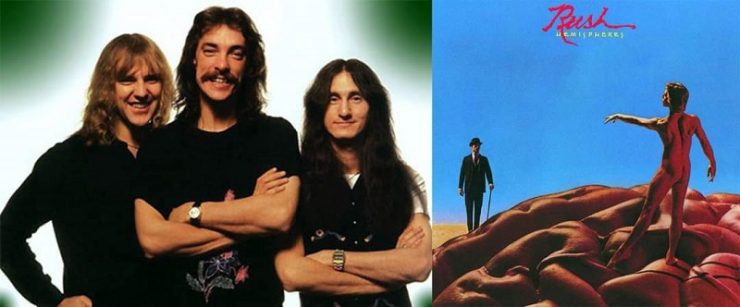RUSH recorded their sixth studio album Hemispheres on October 29, 1978, through Anthem Records. In May 1978, Rush completed their nine-month tour of the United States, Canada and the United Kingdom in support of their fifth studio album, A Farewell to Kings (1977).
The tour helped the band break into the UK market, following a series of well-received performances and “Closer to the Heart”, the lead single from A Farewell to Kings, peaking at number 36 on the UK Singles Chart.
After a short break, the band regrouped to begin work on their next album. In contrast to their previous albums, they entered the songwriting process without any preconceived ideas that proved to be a struggle; Lifeson said “problems start with the basics”. They had enjoyed the experience of recording A Farewell to Kings in Wales at Rockfield Studios, located on a farm in Rockfield, Monmouthshire, and agreed to record there for the Hemispheres.
They initially chose this studio because they had recorded four albums in Toronto and wanted a change; Lee said the United States did not appeal to them, and because they were influenced by many British bands, recording in England became the “natural” choice. Before they entered the studio, the band spent two weeks in intensive rehearsal which sparked concerns from the band about the direction the album was taking.
The condition studio, which is located on a farm, lacks standard amenities including sofas; Lee described it as “really funky”. In one incident, a latch failing to close the studio door frustrated Lifeson who, snugly, removed it, installed a hydraulic door opener, and made a handle on it.
Rush recorded Hemispheres in June and July 1978 at Rockfield Studios with their longtime producer Terry Brown, who is also credited as their arranger, and technician Pat Moran. This marks the longest studio time booked for the band. In comparison, 2112 (1976) was recorded in five weeks and A Farewell to Kings was completed in four weeks.
After the music was finalized, the group settled at Advision Studios in London to record vocals. The album was then mixed in August at Trident Studios in London by Brown and assistant John Brand. In the three month period to put the album together, Rush took only one day off.
The cost of the album was calculated to be around $100,000, making it the band’s most expensive album at the time. Peart recalls the band exhausted by the time it finished and took a six-week vacation to recover, while Lee explained that “we grossly underestimated the level of overload we were aiming for”.
Peart introduced the gong and tympani to the percussion set for the first time; he hadn’t thought of adding an instrument to the previous Rush album, but thought “Hemispheres” needed one.
The tracks are the only growing part of the two-week rehearsal period the group did before entering the studio. Rush had great difficulty recording it because they wanted it set as a live show, rather than a more heavily produced and edited piece.
Lee says it took them about 40 times to come up with something that satisfies them. Peart (and Lee) say they spent more time recording “La Villa Strangiato” than they did the entire album Fly by Night (1975).
Prior to the album’s release, Hemispheres premiered in its entirety on Night at 11, hosted by Rick Ringer at CHUM-FM in Toronto, on October 5, 1978. The album reached number 14 on the Canadian Albums Chart and UK Albums Chart, and number 47 in the US. Billboard 200.
For a short time, Hemispheres was released in Canada on red vinyl with artistic gatefold with poster (catalog number SANR-1-1015) and as a limited edition picture disc (SRP-1300). The album was awarded silver certification in the UK. In the US, Hemispheres proved to be a solid seller in the band’s catalog; the album was certified platinum by the Recording Industry Association of America (RIAA) in December 1993 for selling one million copies, fifteen years after its release.
Track List: (1). Cygnus X-1 Book II: Hemispheres, • Prelude, • Apollo (Bringer of Wisdom), • Dionysus (Bringer of Love), • Armageddon (The Battle of Heart and Mind), • Cygnus (Bringer of Balance), • The Sphere (A Kind of Dream), (2). Circumstances, (3). The Trees, (4). La Villa Strangiato (An Exercise in Self-Indulgence, • I. Buenos Noches, Mein Froinds!, • II. To Sleep, perchance to Dream, • III. Strangiato theme, • IV. A Lerxst in Wonderland, • V. Mosnters!, • VI. The Ghost of the Aragon, • VII. Danforth and Pape, • VIII. The Waltz of the Shreves, • IX. Never turn your back on a Monster!, • X. Monsters!(Reprise),• XI. Strangiato theme (Reprise), • XII. A Farewell to Things.
Rush Personnel: Geddy Lee – bass guitar, Minimoog synthesizer, Oberheim polyphonic synthesizer, Moog Taurus bass pedals, vocals, Alex Lifeson – 6- and 12-string electric and acoustic guitars, classical guitar, Roland guitar synthesizer, Moog Taurus pedals, Neil Peart – drums, orchestra bells, bell tree, tympani, gong, cowbells, temple blocks, wind chimes, crotales. [sources/photo special]
















